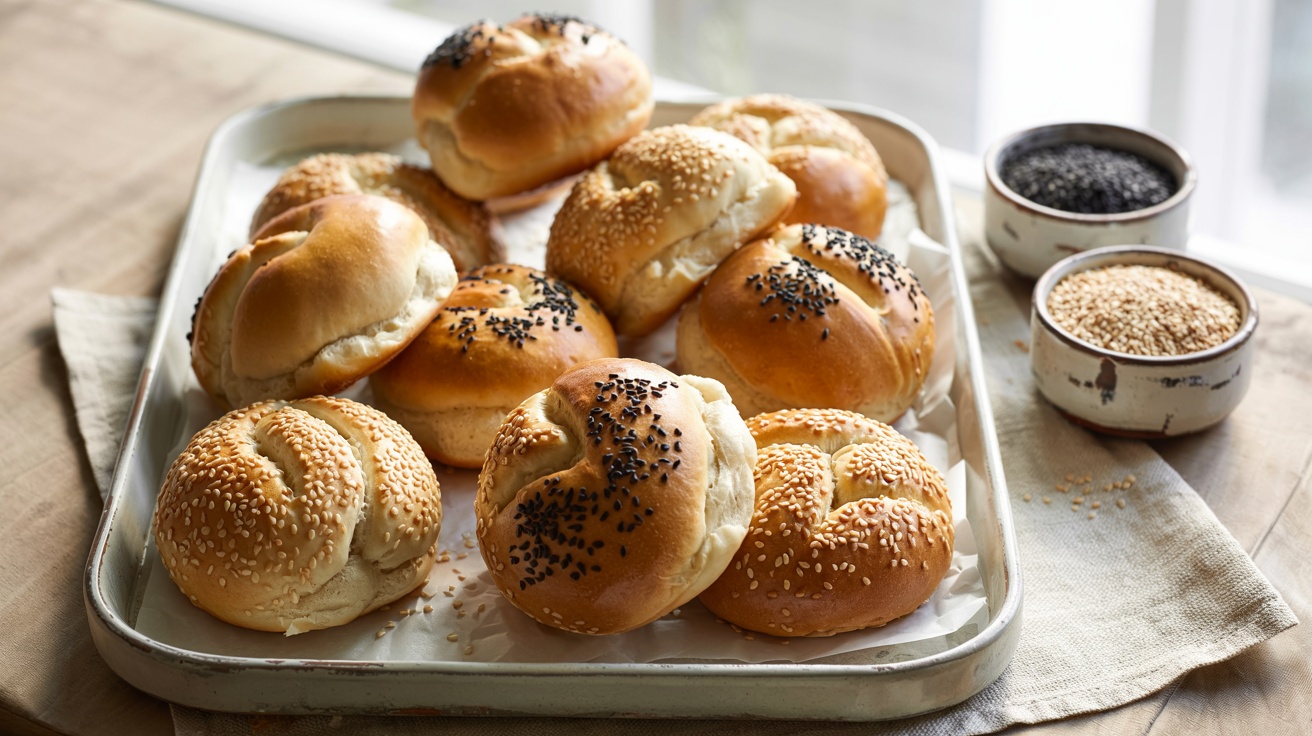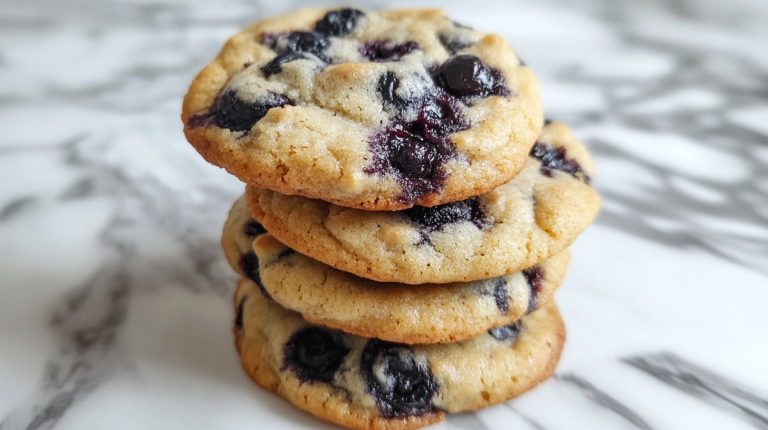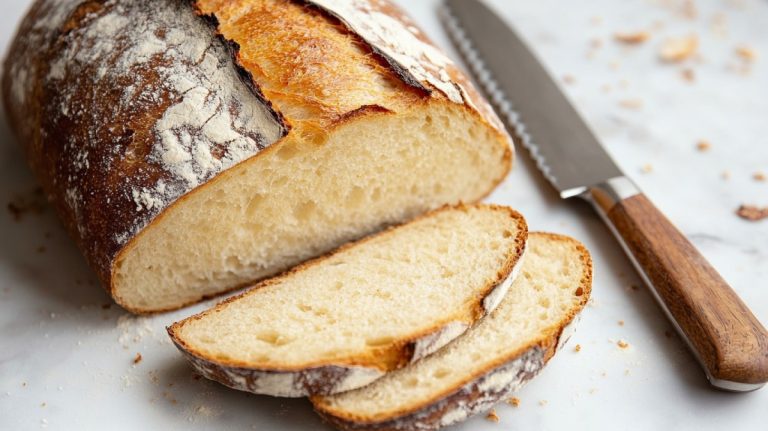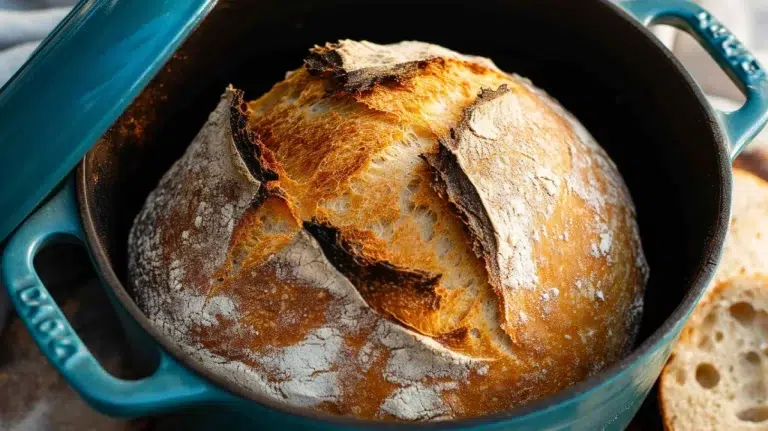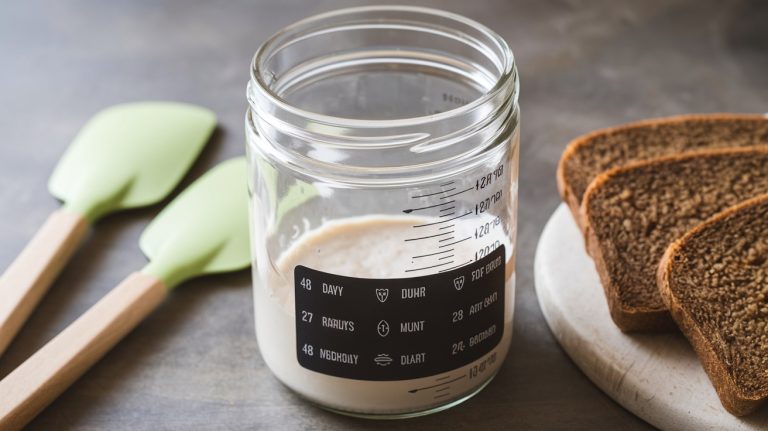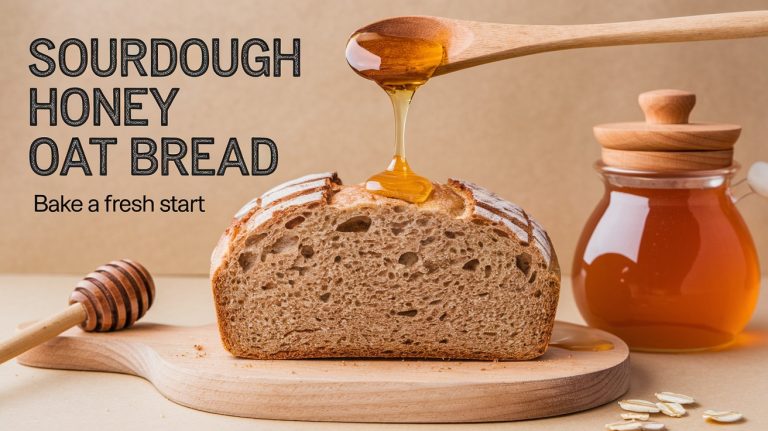Sourdough Kaiser Rolls: The Rise of a Bread Whisperer
Sourdough Kaiser rolls are a delightful achievement of crispy crust and soft, airy crumb. You’ll use bread flour, a sourdough starter, and eggs to create rich dough that ferments naturally for superior flavor.
Shaping these rolls is critical; it involves creating tension and scoring just before baking for an elegant rise. With a nutritional profile that supports a balanced diet, these rolls shine at breakfast, lunch, or elegant dinners. Discover the magic behind their preparation and serving possibilities.
Key Takeaways
- Sourdough Kaiser Rolls are made with bread flour, sugar, sourdough starter, eggs, and sesame seeds for flavor and texture.
- Each roll contains 140-200 calories, with a macronutrient composition of 14% carbohydrates, 3.5% protein, and low fat.
- The preparation involves mixing dry ingredients, kneading the dough, and allowing for initial and final proofing to achieve the desired texture.
- Rolls are shaped to create surface tension and baked at 200°C to 220°C for 20-25 minutes, resulting in a golden brown crust.
- Enjoy Sourdough Kaiser Rolls for breakfast, lunch, or dinner, with various fillings or toppings for a versatile meal option.
Ingredients for Sourdough Kaiser Rolls
When crafting delicious Sourdough Kaiser Rolls, you’ll need a handful of essential ingredients that come together to create a perfect balance of flavor and texture.
Start with bread flour, which provides the necessary structure and crispiness. Sugar not only adds a subtle sweetness but also aids fermentation, while salt enhances the overall flavor profile. Your sourdough starter is vital, offering natural leavening that gives the rolls their signature rise. The dough is made with 100% bread flour, ensuring a sturdy foundation for the rolls. Additionally, using a consistent feeding schedule for your starter will ensure its robustness and effectiveness in the fermentation process.
Don’t forget the eggs; they enrich the dough with moisture and richness. For an extra touch, consider adding malt syrup for depth and a beautiful golden crust. Finally, topping with sesame seeds can elevate both appearance and taste.
Preparation Methods
With the ingredients ready, it’s time to bring your Sourdough Kaiser Rolls to life through a series of precise preparation methods.
Start by pre-fermenting flour to enhance fermentation speed. Mix dry ingredients, then add your sourdough starter and water, achieving the right dough consistency.
Begin the process by pre-fermenting flour, then combine dry ingredients with your sourdough starter and water for optimal dough consistency.
If you’re using a stand mixer, knead until the dough is smooth and elastic, or mix by hand with a wooden spoon if you prefer. Dough rising is crucial for achieving the unique soft, dense crumb of the rolls. Ensuring that you have the right temperature control features can significantly improve the fermentation process.
After the initial proofing in a warm, draft-free environment, divide the dough into equal portions.
Allow these portions to rest briefly, ensuring they’re ready for the next stage.
Shaping and Forming Rolls
As you begin shaping your rolls, focus on creating surface tension by pulling the dough toward the center, forming a tight ball. This foundational step sets the stage for your final roll shaping, where you’ll skillfully roll out each ball into a disk and employ precise folding techniques to achieve that iconic Kaiser roll design.
Mastering these techniques guarantees each roll bakes to perfection, with a beautiful crust and a soft, airy interior. Remember to score the dough just before baking to allow for controlled expansion and an appealing crust. Experimenting with sourdough as a substitute can elevate your rolls to new heights, enhancing flavor and texture.
Creating Surface Tension
Creating surface tension in your sourdough Kaiser rolls is essential for achieving that perfect, airy crumb and beautifully rounded shape.
Start by dividing your dough into uniform pieces, each weighing around 75-80 grams. Roll each piece in a circular motion against a clean surface, enhancing the tension. Using a longer blade can help you slice through the rolls smoothly once baked.
After forming the balls, let them rest for about 20 minutes under a cloth to relax the dough, allowing for easier shaping. Gently flatten each ball into a circular disk, ensuring you maintain that precious tension.
Dust your work surface with rye flour to prevent sticking, and handle the dough with care to avoid any tears. This meticulous process sets the stage for the delightful rolls you’re about to create.
Final Roll Shaping
Once you’ve perfected the surface tension of your dough, it’s time to focus on the final shaping of your sourdough Kaiser rolls.
Start by chilling your dough on a parchment-lined sheet, allowing it to relax for about 20 minutes. This enhances pliability, making shaping easier. Proper airflow during fermentation is crucial for optimal dough texture.
Divide the dough into uniform portions of 75–80 grams, then choose your preferred technique—knotting, twisting, or folding. Each method brings a unique flair to your rolls. Active Sourdough starter contributes to a rich flavor and texture in your rolls.
Don’t forget to coat them lightly with rye flour to prevent sticking.
After shaping, let the rolls rest for 15 minutes before proofing until doubled in size.
Baking and Finishing

When you bake sourdough Kaiser rolls, achieving the perfect crust and texture is essential to elevate your creation.
Start by preheating your oven between 200°C to 220°C (392°F to 428°F), and guarantee your dough has fully proofed. Incorporating sourdough starter into your dough enhances the flavor profile significantly, as a healthy starter should double in size to ensure good rise.
- Create steam by placing a pan of boiling water on the oven floor; this enhances the crust.
- Flatten dough balls into disks, then knot them for that classic shape before they rest.
- Monitor the baking time, aiming for 20-25 minutes, until the edges turn golden brown.
- Finally, cool your rolls on a wire rack to maintain crispness.
Nutritional Information
Understanding the nutritional information of sourdough Kaiser rolls is essential for making informed dietary choices.
Each roll packs a caloric punch, primarily derived from carbohydrates, while offering a moderate amount of protein and minimal fat. One roll contains 200 calories, making it a satisfying option for a snack or part of a meal.
As you explore their health considerations and benefits, you’ll see how these rolls can fit into your overall nutrition plan.
Caloric Breakdown Per Roll
A typical sourdough Kaiser roll ranges between 140 to 200 calories, making it a satisfying yet mindful choice for those watching their caloric intake.
The unique fermentation process of sourdough can contribute to its nutritional advantages, often resulting in a lower glycemic index compared to traditional rolls.
Here’s what you can expect:
- Caloric Range: Most rolls fall between 140-200 calories.
- Ingredient Impact: Flour type can greatly affect caloric content.
- Natural Fermentation: Enhances nutrient bioavailability and reduces phytate levels, leading to better mineral absorption for your body.
- Mindful Consumption: Ideal for those aiming for a balanced diet without sacrificing flavor. Additionally, these rolls have a shelf life of 7 days at ambient temperatures, which allows for better planning in meal preparation.
Macronutrient Composition Overview
Sourdough kaiser rolls, with their unique fermentation process, boast a remarkable macronutrient composition that enhances both flavor and nutritional value.
Each roll weighs about 57g, with an impressive water content of approximately 80.7%, translating to about 46g per roll. You’ll find around 14% carbohydrates, equating to roughly 8g, providing a satisfying energy source. The use of sourdough starter not only contributes to the intricate flavor but also aids in the fermentation process.
Protein content hovers at 3.5%, or about 2g per roll, while the fat remains low at 1.7%, about 1g. Remarkably, these rolls contain 0% alcohol, thanks to the fermentation process. Additionally, the Extra Large White Kaiser Bun offers a versatile option for sandwiches and burgers, making it a great choice for various meal occasions.
Health Considerations and Benefits
While enjoying the delightful taste of kaiser rolls, you might be surprised to learn about their impressive health benefits. Sourdough fermentation not only enhances flavor but also boosts nutritional value, making these rolls a smart choice for your diet.
Consider these advantages:
- Easier digestion through breakdown of complex carbohydrates and proteins. This process allows the body to absorb nutrients more effectively, contributing to better nutrient availability. Additionally, the fermentation process helps reduce anti-nutrients, improving overall nutrient absorption.
- Lower glycemic index, aiding in stable blood sugar levels.
- Increased nutrient absorption due to reduced phytic acid.
- Support for gut health, thanks to probiotics developed during fermentation.
Incorporating sourdough kaiser rolls into your meals can enhance fiber intake, improve energy stability, and help manage portion sizes.
Variations and Adaptations
When experimenting with variations and adaptations of Kaiser rolls, you’ll discover a world of possibilities that can elevate your baking experience.
Adjusting hydration levels can yield softer rolls, while increasing your sourdough starter percentage enhances flavor and fermentation speed. For a richer taste, incorporate eggs, sugar, or oil. Additionally, higher hydration can significantly improve the overall texture of your rolls, making them more enjoyable to eat and enhancing nutrient absorption as well.
If you prefer a tender texture, opt for all-purpose flour, but note it may sacrifice crispiness. To create visual appeal, sprinkle poppy seeds or your favorite toppings.
For a softer crumb, boost hydration and oil content; to maintain a crispy crust, bake at lower temperatures.
Tips for Success
Achieving perfect Kaiser rolls requires attention to several key factors that can markedly impact your results.
Focus on these essential tips for success:
- Use Bread Flour: It offers the necessary structure and strength for your rolls.
- Master the Shaping Techniques: Experiment with knotting and scoring to achieve that classic appearance and texture. Additionally, ensure you stretch and fold the dough properly during shaping to help maintain its structure.
- Pay Attention to Proofing: Allow the dough to rise adequately during both proofing stages for ideal flavor and texture.
- Bake with Steam: Create a steamy environment in the oven to enhance crust crispiness.
Serving Suggestions
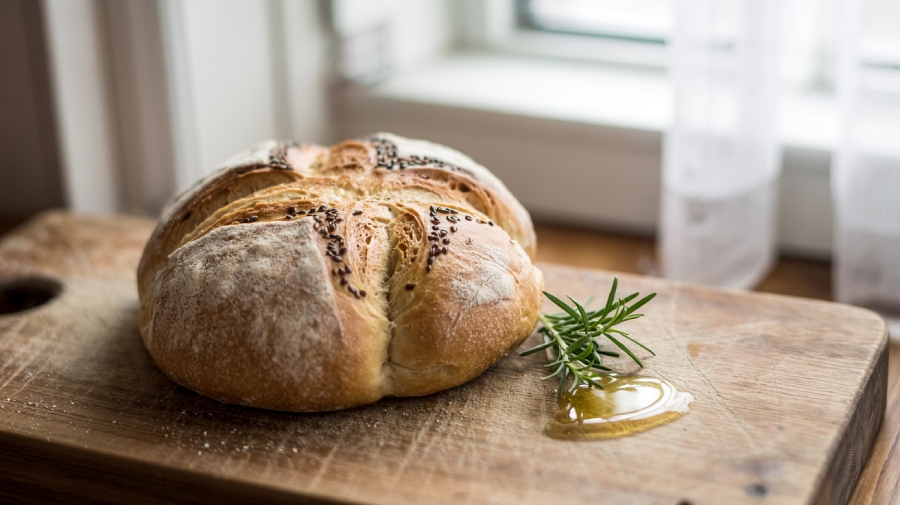
Kaiser rolls are incredibly versatile, making them perfect for a variety of meals throughout the day. For breakfast, layer a sunny-side-up egg, crispy bacon or prosciutto, fresh spinach, and your favorite cheese like Cheddar or Swiss for a savory morning treat.
At lunch, create classic sandwiches with ham, cheese, lettuce, and tomato, or elevate your meal with prosciutto and a smear of mustard. For casual dinners, stuff them with pulled pork or juicy burgers, and add coleslaw for a crunchy finish.
For gourmet occasions, indulge in smoked salmon with cream cheese, or roasted vegetables paired with hummus. Serve these rolls with soups, salads, or as part of a charcuterie board for stunning presentation and delightful flavors. Additionally, these rolls can be made in advance and refrigerated, allowing for easy preparation during busy days minimal effort required.
Frequently Asked Questions
Can I Use a Different Type of Starter?
Absolutely, you can use a different type of starter! Each starter brings unique qualities to your dough.
For instance, a whole wheat starter adds depth, while a rye starter introduces a distinctive flavor. You might even experiment with a discard starter to reduce waste without sacrificing results.
Just remember, the type of starter you choose affects fermentation speed, flavor profile, and texture, so embrace the variations to create something truly special!
How Do I Know if My Dough Has Risen Enough?
How can you tell if your dough has risen enough?
Look for a dough that’s doubled in size, with a smooth, rounded appearance.
Use the finger poke test—if the indentation remains, you’re on the right track.
It should feel light and slightly wobbly.
Keep an eye on the time, but trust your instincts; each batch has its unique rhythm.
Adjust based on your environment, and you’ll master the art of perfect dough rising.
Can I Freeze the Rolls After Baking?
Yes, you can freeze the rolls after baking.
To maintain their freshness, wrap them tightly in plastic or aluminum foil, then store them in an airtight container or freezer bag. This prevents moisture loss, ensuring they stay delicious.
Keep your freezer at a constant temperature for best results.
When you’re ready to enjoy them, thaw overnight at room temperature or reheat in the oven for that fresh-baked taste you love.
What Should I Do if My Dough Is Too Sticky?
If your dough’s too sticky, start by adding flour gradually, just a tablespoon at a time.
Resting the dough longer will help develop gluten and improve its structure.
Use kneading techniques like stretch and folds to enhance texture.
Remember to monitor your environment—humidity can exacerbate stickiness.
Finally, verify your flour’s high-protein, and keep your hydration between 65-70% for ideal results.
You’ll achieve a smoother, more manageable dough in no time!
How Can I Store Leftover Rolls?
To store leftover rolls, let them cool completely to avoid moisture buildup.
Place them in an airtight container to keep them fresh for several days.
If you want to extend their shelf life, wrap each roll in aluminum foil or plastic wrap and store them in freezer-safe bags.
For short-term storage, consider using a bread box to maintain their crust.
Avoid refrigeration, as it may dry them out more quickly.
Kneadless to Say, You Nailed It
So, there you have it! You’ve mastered the art of sourdough kaiser rolls, proving once and for all that you’re not just another kitchen amateur. Your friends will be so amazed, they might even start calling you
“The Bread Whisperer.” Who needs a fancy bakery when you can whip up these golden beauties at home? Just remember, with great rolls comes great responsibility—don’t forget to share, or you might find yourself rolling solo while everyone else enjoys your masterpiece.

